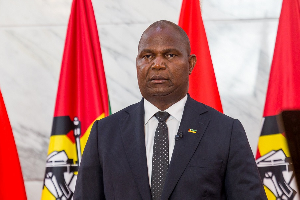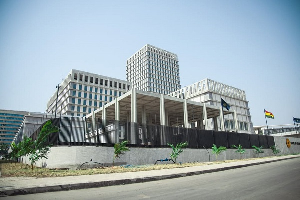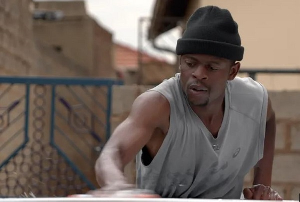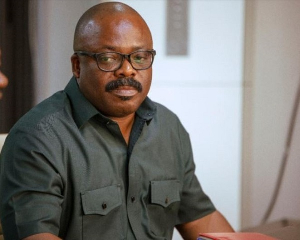By Samuel Adadi Akapule
When it comes to the achievements and successes chalked by the Ghana Health Service in Ghana, one cannot rule out the fact that Dr.John Kokou Awoonor-Williams, the Regional Director of Ghana Health Service in charge of the Upper East Region stands tall among the giants who have contributed positively to the development of that sector.
In fact, he has distinguished himself beyond reasonable doubt in the Service and could rightly be described as one of the legendaries in the Ghana Health Service.
Why would one say so? His strides at solving the enormous problems in the sector particularly in the Upper East Region are there for all discerning people to see.
Prior to the arrival of Dr. Awoonor-Williams to the Upper East Region in 2008, critical infrastructure and logistics needed for meaningful and quality health care delivery in the region were in serious deficit. The health sector in the region started seeing visible signs of transformation within days of his coming into office.
The two-storey administration block housing the Regional Health Directorate had deteriorated badly and had no functional communication systems. Today, that building is a sight worth seeing from inside and out. It has been renovated and refurbished to the admiration of all and now referred by the people in the Region as a “White House of the Upper East.” What is even more important is that, that structure was reconstructed from internally generated funds initiated by the Regional Director. It is now ultramodern super structure, befitting and providing a pleasant working environment for the staff of the Regional Health Directorate.
He is not that type who believes in the “create and share” syndrome where creators greedily fatten their pockets. He chooses to spend the resources judiciously for the good of everyone in the Region and the country as a whole.
As if that was not enough under his good leadership style, 14 staff bungalows and low cost quarters housing staff of the service at Soe and Zaare have been rehabilitated and expanded, while new ones have been constructed at Zebilla, Bongo and Paga in the Kasena-Nankana West district. The Doctors’ bungalows, which were in serious disrepair and unfit for doctors habitation have been rehabilitated and fully furnished for them to stay comfortably and take care of the health needs of the people. This has helped ease the problem of staff accommodation which has been one of the key reasons why medical doctors and other health workers run away from the region.
It should be pointed out that before Dr. Awoonor-Williams assumed office in the Region as the Director in charge of the Upper East Regional, the doctors’ bungalows, Low Cost and Junior staff quarters for staff of the hospital were so dilapidated, bats-infested and not habitable and within the short period of less than a decade of his leadership, these have been turned into plush accommodations for doctors and health sector staff.
The refusal of doctors and other health staff to accept postings to the Upper East Region is now becoming a thing of the past. Unlike the past, where doctors who accepted posting to the Region immediately declined to serve because of varied reasons including the lack of good residential accommodation facilities and good working environment, today the story is different. Some doctors now are more than willing to accept postings to the region irrespective of the lack of other social needs such as first class schools to enroll their wards, visiting big super markets to shop for the homes among others. Those who accept postings to the region now are housed in well furnished and secured bungalows befitting their training and sacrifice. As of now, more new doctors are present in the region and giving quality health care delivering whilst more are also now willing to come to serve in the region all because of the proven genius in the administration of Dr.
Awoonor-Williams.
For his good leadership and foresight, the Director has initiated the construction of a conference facility in the region with contributions from the DHMTs which is at the verge of completion. We all know how much funds are wasted in hiring venues and conference facilities to hold meetings and roundtable discussions on pertinent development issues. This is in fact one of the best methods of adopting a cost-saving strategy for the development of institutions and all Heads of Institutions must emulate the shining example of Dr Awoonor-Williams.
The sprung up Community Health based Planning Services (CHPS) compounds under his leadership is another area he devoted much attention to. Currently CHPS spread across all deprived communities in the region with the aim of bringing health care delivery to the doorsteps of the people. People in deprived areas in the Region no longer have to commute long distances to access healthcare. What is more interesting is that Dr. Awoonor-Williams has initiated what he calls “Pregnant Women Go to School” at some of the CHPS compounds where he himself is mostly in attendance to educate pregnant women on the processes involved during pregnancy and after birth. This laudable imitative has reduced the maternal mortality rate in the Region.
This was what the Youth of Upper East has to say about him when they honoured him in 2010 for his distinguished work in the Region “We honoured Dr. Awoonor-Williams because when the flood disasters struck the Northern and Upper Regions in 2007-2009, a number of health facilities including CHPS Compounds were affected, some to the extent that they could not be used. Currently, eight of the flood affected CHPS compounds have been put back to good shape and are in use at Navio, Kajelo, Pindaa, Mayoro, all in the Kassena-Nankana West District, Kaljiisa in the Builsa District, Gorogo in Bongo District, Kpatia in the Garu-Tempane District and Teshie in the Bawku West among others”
Other infrastructural projects tirelessly pursued by Dr. Awoonor-Williams to boost the health sector in the Region are the eye unit at Chiana, expansion of the maternity wing of the Paga health centre, the construction of the ultra-modern regional cool room with offices and fence wall for disease control unit as well as the extension and refurbishment of the regional medical stores.
With his lobbying skills all the nine District Health Management Teams (DHMTs) in the region have been provided with brand new utility pickups, tri-cars, and motor cycles to facilitate and ease the transportation of medical supplies to hard-to-reach communities and health facilities.
Again if one has been following development in the health sector closely in the region then one must be conversant with the plight of health training institutions in the region before the Director took office. Interestingly, what others could not do Dr. Awoonor-Williams in two years managed to change the situation. As it stands, the Health Assistance Training School which used to be in a dilapidated structure has been moved to a new building at Zuruangu and now operates in a more convenient space even though the infrastructure there are far below what is currently required.
At the Nurses’ Training College in the Bolgatanga Municipality, “the forgotten boys’ hostel” there has been renovated. At the Community Health Nurses Training School in Navrongo, an assembly hall complex has been constructed. In fact, the list of physical structures renovated or raised from the scratch by Dr. Awoonor-Williams in his reign in office is very tall.
An ultra-modern regional hospital, a polyclinic and three district hospitals for Garu-Tempane, Talensi-Nabdam and Kassena-Nankana West are also in the pipeline all under his able leadership.
Medical supplies have more than tripled since the arrival of Dr. Awoonor-Williams and the region now has a delivery van for drug distribution. The Navrongo Hospital has also been equipped with theatre equipment to the admiration of all.
About 120 staff of the service that had worked over 7-17 years as casual workers and were paid meager wages, had no retirement benefits and never enjoyed staff benefits are now happy because they are now permanent employees of the service as a result of the compassionate leadership of Dr. Awoonor-Williams.
The CEO also has also written extensively on health issues published in the Dailies which have contributed to improve the health status of the people.
This writer who spoke to a number of health workers directly or otherwise working with Dr. Awoonor-Williams commended him for his good human relationship. Majority of the Staff and people in the area refer to him as the “innovative engine of health” or “Saviour“ of the Region.
Due to his hard work and diligence he has received a lot of National and International awards and facilitated a lot of workshops also at the national and international levels. The Director comes to work as early as 8am and close late usually at 11pm. Most people referred to him as somebody who has the passion for the job. Sometimes he goes to work in any of the facilities that is under pressure and needs additional hands.
What should the people in the region especially the citizens from the area be doing for such a leader? Such a leader needs to be given the necessary encouragement and supports to enable him accomplish his laudable objectives.
There is the need for the citizens from Bolgatanga, Nangodi, Bongo, Tongo (BONABOTO) Association to ensure that such a leader is given all it takes to bring about more positive change in the region especially on health issues considering the state of the region regarding health needs.
The top hierarchy of the Ghana Health Service must also recognize the role played by the Director in improving upon the health sector in the region and give him all the needed support.
In fact Dr. Kokou Awoonor-Williams is a legendary in the Ghana Health Service and deserves much recommendation. His leadership style should be emulated by all to help champion the development of the nation forward.
The writer considers this article incomplete without asking these rhetoric questions. If this man could bring all these massive infrastructure and innovations in health administration in less than half a decade, then what could have gone wrong all these years? Where were the leaders? When and how do we get them to continue when duty calls Dr. Awoonor to another station? This is food for thought.
samuelakapule@yahoo.com
Health News of Friday, 5 August 2011
Source: Akapule, Samuel Adadi












